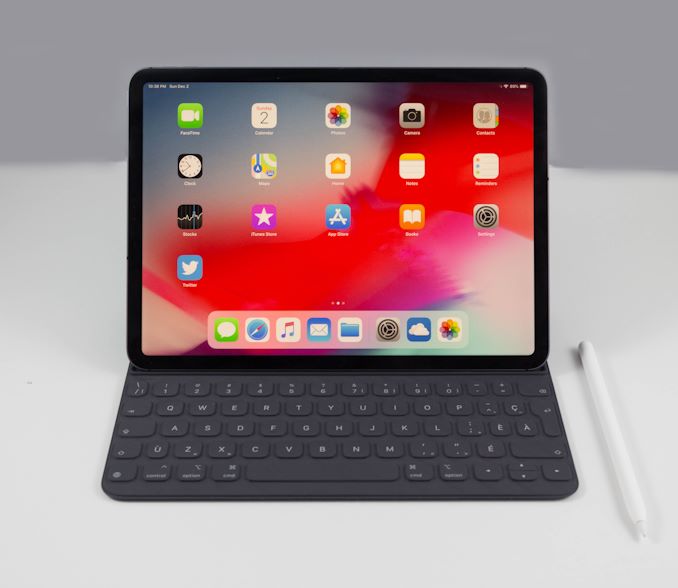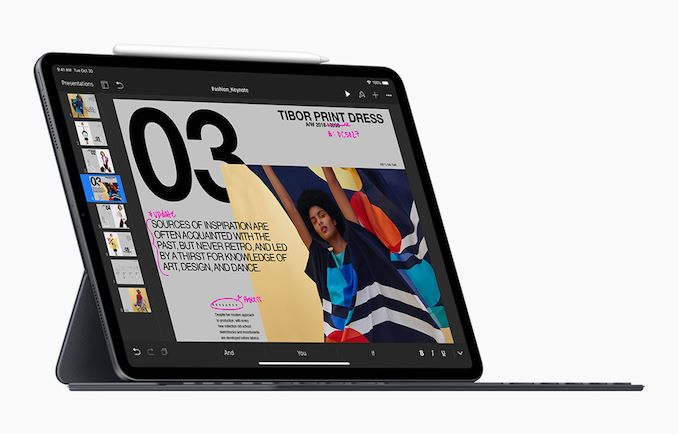The 2018 Apple iPad Pro (11-Inch) Review: Doubling Down On Performance
by Brett Howse & Andrei Frumusanu on December 4, 2018 10:00 AM EST
I think it’s safe to say that in 2018, the tablet market has not shaped up like anyone had expected, not even Apple. Tablets weren’t the next smartphone – and indeed the sales of dedicated tablets are downright soft – and yet at the same time tablets have successfully carved out a meaningful niche for themselves. But more importantly still, the tablet concept is everywhere even if “pure” tablets themselves aren’t. One needs only look at all the various PC 2-in-1s and convertibles to see the influence tablets have made on the traditional laptop market, forcing these many clamshells into becoming something more.
As a consequence of the introduction of modern tablets and their subsequent efforts to secure their own place in the market, we’ve essentially seen the tablet and tablet-alike market bifurcate into two real clusters of tablet designs. On the one hand are the cheap content consumption devices – the iPads, Fire TVs, and myriad of cheap Android tablets. On the other hand is the far more exclusive market for high-end, productivity-oriented tablets; devices that don’t just consume content, but create it as well. This market has been slower to develop, but it’s also important for its own reasons, as it’s the real crossover point between tablets as envisioned by the iPad, and the traditional PC laptop market.
Apple for their part has opted to go after both of these markets, and has done so successfully. The traditional 9.7-inch iPad needs no introduction, and while the iPad Pro is a little less known, the difference isn’t by much. Built upon the shoulders of the original iPad, the iPad Pro family takes things one step further, building towards not just a bigger and better iPad, but by giving the tablet the features that are needed for productivity and content creation, at both a hardware and a software level. The iPad Pro doesn’t try to be a traditional laptop, but it certainly tries to capture a lot of their usefulness, and this is especially the case for the 2018 iPad Pro.
With the introduction of the latest iPad Pro models, Apple’s iPad lineup for 2018 offers arguably the largest design change since the original iPad launched. The new design offers a much higher screen-to-body ratio than ever offered before, mimicking what they’ve done with the iPhone lineup. As a result, Apple has more or less reinvented the iPad Pro design, and offers plenty of new features inside and out.
Apple’s ambitions with the iPad Pro start with their chip design team, which has created the Apple A12X System on a Chip to power the latest iPad Pro. As outlined in our iPhone XS review, the A12 series of SoCs are already well ahead of the ARM competition, and Apple clearly has its sights on the performance levels of x86 CPUs from Intel. A12X features four Apple Vortex CPU cores, double that of the regular A12 in the iPhone, and seven A12 GPU cores which Apple says provides the power of an Xbox One S in a device with a far smaller power budget.
For better or worse, the iPad Pro is attached at the hip with Apple’s mobile operating system iOS, and unsurprisingly the iPad Pro ships with the latest version, iOS 12.1.
Apple’s iPad Pro lineup has also been their test bed for their newest display technology, and the iPad Pro keeps the 120 Hz ProMotion display, which offers variable refresh rate down to 24 Hz, along with P3 display gamut coverage tied in with their color managed software. Apple also keeps their True Tone option to dynamically adjust the white balance of the display to match the lighting conditions of the room it’s in.
|
Apple iPad Pro Comparison |
||
| iPad Pro 11-Inch (2018) |
iPad Pro 12.9-Inch (2018) |
|
| SoC | Apple A12X 4x Apple Vortex 4x Apple Tempest 7 core A12 GPU |
|
| Display | 11-inch 2388x1668 IPS LCD P3 D65, 120Hz |
12.9-inch 2732x2048 IPS LCD P3 D65, 120Hz |
| Dimensions | 247.6 x 178.5 x 5.9 mm 468 / 468 grams (WiFi / LTE) |
280 x 214.9 x 5.9 mm 631 / 633 grams (WiFi / LTE) |
| RAM | 4 GB (up to 512 GB Storage) 6 GB (1 TB model) |
|
| NAND | 64GB / 256GB / 512GB / 1TB | |
| Battery | 29.37 Wh | 36.71 Wh |
| Front Camera | 7MP, f/2.2, Smart HDR, Wide Color Gamut, Retina Flash | |
| Rear Camera | 12MP, f/1.8, PDAF, Smart HDR, Wide Color Gamut, True Tone Quad-LED flash |
|
| Cellular | 2G / 3G / 4G LTE (Category 16) Intel XMM 7560 Modem |
|
| SIM Size | NanoSIM | |
| Wireless | 802.11a/b/g/n/ac 2x2 MIMO, BT 5.0, GPS/GLONASS | |
| Connectivity | USB-C Apple Smart Connector |
|
| Launch OS | iOS 12.1 | |
| Launch Price | Wi-Fi: $799 (64GB) $949 (256GB) $1149 (512GB) $1549 (1TB) Wi-Fi + LTE: $949 (64GB) $1099 (256GB) $1299 (512GB) $1699 (1TB) |
Wi-Fi: $999 (64GB) $1149 (256GB) $1349 (512GB) $1749 (1TB) Wi-Fi + LTE: $1149 (64GB) $1299 (256GB) $1499 (512GB) $1899 (1TB) |
Apple has also taken the opportunity to switch the iPad Pro lineup over from their proprietary Lighting connector to the more ubiquitous USB-C port, making this the first iOS device to offer USB connectivity. Where they give, they also take away though, and the 3.5 mm headset jack has gone the way of the Dodo, and for more or less the same reasons.
For those that want to work on the go, Apple continues its excellent tradition of offering cellular connectivity with the iPad Pro, and those that need a lot of storage will be happy to see models up to 1 TB, which is more important because the iPad offers no way to access external storage to increase this.
What first set the iPad Pro apart from the rest of the iPad lineup was the ability to use the Apple Pencil as well as a first-party keyboard solution. For the 2018 iPad Pro, both of these accessories have gotten refreshes as well.
The iPad Pro for 2018 is a major change from the outgoing models. Let’s dig in and see how it fares.











145 Comments
View All Comments
melgross - Tuesday, December 4, 2018 - link
Eh, OLEDs don’t do it either. Last year I went to an audio trade show I go to every year, and Sony was demo’ing among other things, two large TVs. One was an OLED, and the other and LCD. Both were expensive at $9,000.I asked the engineer which he would recommend for HDR and he said the LCD. The truth is that OLEDs simply don’t get bright enough. Black levels aren’t as important.
Spunjji - Wednesday, December 5, 2018 - link
I'm not sure that's entirely accurate, except for from a strict ""adherence to specifications" view. In reality, past a certain level of brightness, a TV with better contrast will look superior in an environment with controlled lighting than a brighter display that has visibly worse contrast.mlambert890 - Wednesday, December 5, 2018 - link
These reviews all seem to ignore that the iPad Pro 10.5 ever existed.This is weird because for all the talk of “this is the iPad Apple always wanted to make!” its largely the iPad they made last year, but for a fair bit more money and with more marketing hype.
Sure the CPU/GPU is even faster than the A10X, and there is now ML acceleration, but hardware hasn’t mattered on the iPad since the Air 2. There is literally nothing that runs poorly on the 10.5 at all. It even has the same 120hz “Liquid Retina” screen. Unless you are in the tiny niche of people who edit 4K video *on the iPad* (or pretend to need to), there is really no benefit from the extra CPU power.
The “revolutionary design” looks exactly the same to 99.9% of people. Especially once in a case. And in exchange for this design, you get .5” of screen, but lose the home button, fingerprint reader and headphone jack. You also lose accessory compatibility in both directions. So there is real drawback there.
For someone wanting to jump on an iPad Pro now, the new one obviously makes sense. But this is always true. Pretending that this latest iPad is more than just iterative is really disingenuous, yet every single article is treating it like we’ve gone from Air 2 -> Pro 11”
markiz - Wednesday, December 5, 2018 - link
I don't get it why do you think it's so hard to compare performance between OSes and devices?Who cares what are the absolute scores for the SoC itself, what matters is real life performance.
Is there no such benchmark, that would measure some common (or less common) scenarios, like:
- take a camera where you have some video
- transfer it to a pc
- do whatever editing you need to do
Or, like, loading and scrolling through 100 most popular webpages?
Paying your bills in online banking?
Buying a thing on amazon?
The Garden Variety - Wednesday, December 5, 2018 - link
Well thank goodness you so clearly defined the methodologies—"do whatever editing you need to do"—so it should be a totally clear and reproducible set of results within your comparison. Oh wait. What are we measuring using your system, again? Time? Against what scale? What if one task requires a different set of procedures on one operating systems than the other, which is your baseline?I don't mean to be a complete prick, but I don't think I'm too far out of bounds here to call your entire message one of the stupidest fucking things I've read yet today. But the day is young, so you've got that going for you.
sonny73n - Wednesday, December 5, 2018 - link
Many fanboys here are praising A12x which is faster than A11 but considering the price of the iPad, is it faster than the mobile Ryzen 5 or the Core i5? And for an additional 936GB of storage, you have to pay $750 more. I thought 1TB of NAND flash cost about $130 now. What a ripoff! This is straight up robbery and I refuse to be the victim.WasHopingForAnHonestReview - Wednesday, December 5, 2018 - link
Comments are filled with paid social media posters. This thing is absolutely overpriced and you STILL dant do everything you want on it. (Ios)Oyeve - Wednesday, December 5, 2018 - link
At the end of the day it's still an ipad. ios is so limited. Why doesnt apple just make a MBP in an ipad sized format?blackcrayon - Wednesday, December 5, 2018 - link
With an A12X chip? I think they're working on that.With intel chips, you're basically asking for a 12" Macbook - iPad sized, but hampered by what intel is able to give us in that form factor.
Also at the end of the day a MBP is just a MacBook Pro, so I'd still prefer they offer what the iPad can do as a separate product for now.
isthisavailable - Wednesday, December 5, 2018 - link
Please compare this to the Core M series fanless chips from intel. Apple is probably already ahead of core M.